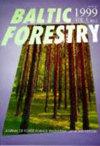棕熊生态相关自然保护区物候观察
IF 0.6
4区 农林科学
Q3 FORESTRY
引用次数: 0
摘要
保存在俄罗斯联邦自然保护区的《自然编年史》(Letopis Prirody)汇集了广泛而系统的野外记录。其中特别有趣的信息是浆果成熟的时间和它们的产量,因为浆果是许多野生动物物种的重要食物,包括棕熊(熊),俄罗斯北部欧洲的核心物种。这种营养联系在秋季熊的增肥期或嗜食期表现得最为明显和有趣,此时动物们依靠浆果来储存脂肪。通过对Kivach自然保护区(中部针叶林)和Pinega自然保护区(北部针叶林)的野外食肉动物饮食资料和《自然编年史》记录的综合分析,确定了棕熊的生态关系。我们已经确定了从森林道路和小径沿线取样的棕熊粪便中某些食物的流行率(%)。沿永久样条测定了结果楸树(Sorbus aucuparia)的数量和生产力。越橘(Vaccinium myrtillus)和越橘(Vaccinium vitis- idea aea)浆果在棕熊的饮食中占主导地位。浆果成熟日期(19-43天)和平均产量(得分1.3 - 5.0)在不同年份变化很大。成熟开始日期的趋势遵循提前日期的矢量。在Pinega NR中,这个过程的速度在越桔中更快。沿土路结果的野田鼠数与野田鼠患病率的等级相关系数为r=1。结果表明,果实数量与果实产量之间也存在显著的相关关系。棕熊粪便中不同食物在嗜食期的流行表明物种的高饮食可塑性。在Pinega NR中,秋天最后一次看到棕熊的踪迹与沼泽越橘和rowan浆果成熟的开始之间存在可靠的强相关性。欧洲俄罗斯中部和北部针叶林中棕熊相对稳定的食物供应是该物种数量多、分布广的因素之一。关键词:《自然纪事》,自然保护区,中北部针叶林亚区,增肥食物,浆果结果,营养环节,膳食可塑性,熊熊本文章由计算机程序翻译,如有差异,请以英文原文为准。
Phenological observations on protected natural areas associated with brown bear (Ursus arctos L.) ecology
The Chronicles of Nature (Letopis Prirody) kept in the nature reserves of the Russian Federaton aggregate a wide spectrum of systematic field records. Information of particular interest therein is the timing of ripening of berries and their yields across years, since berries are an important food for many wildlife species, including brown bear (Ursus arctos), a core species in boreal European Russia. Such trophic links are most explicit and interesting in the autumn during fattening or hyperphagia period in bears, when the animals depend on berry availability for storing up fat. We aimed to identify the ecological relationships of brown bear applying integrated analysis of field data on the carnivore diet and of records from the Chronicles of Nature of the Kivach Nature Reserves (the middle taiga) and the Pinega Nature Reserve (the northern taiga). We have determined the prevalence (%) of the certain foods in brown bear scats sampled from transects along forest roads and paths. The number and productivity of fruit-bearing rowan trees (Sorbus aucuparia) were determined along permanent transects. Bilberry (Vaccinium myrtillus) and cowberry (Vaccinium vitis-idaea) berries dominate in brown bear diet. Berry ripening dates (19-43 days) and the average yield (scores 1.3 to 5.0) vary greatly over years. Trends in ripening onset dates follow a vector towards earlier dates. In the Pinega NR, the rate of this process is faster in bilberry. The coefficient of rank correlation between the number of fruit-bearing rowans along dirt roads and rowan prevalence in scats was r=1. The same significant correlation was found between the number of fruit-bearing rowan trees and rowan berry yield. The prevalence of different foods in brown bear scats during the hyperphagia period shows the high dietary plasticity of species. A reliable strong correlation was detected in the Pinega NR between the last sighting of brown bear tracks in autumn and the onset of berry ripening in bog bilberry and rowan. The relatively stable food supply for brown bear in the middle and northern taiga of European Russia is one of the factors defining the high numbers and wide distribution of the species. Keywords: Chronicles of Nature, nature reserves, middle and northern taiga subzones, fattening foods, berry fruiting, trophic links, dietary plasticity, Ursus arctos.
求助全文
通过发布文献求助,成功后即可免费获取论文全文。
去求助
来源期刊

Baltic Forestry
农林科学-林学
CiteScore
1.60
自引率
0.00%
发文量
23
审稿时长
>12 weeks
期刊介绍:
The journal welcomes the original articles as well as short reports, review papers on forestry and forest science throughout the Baltic Sea region and elsewhere in the area of boreal and temperate forests. The Baltic Sea region is rather unique through its intrinsic environment and distinguished geographical and social conditions. A temperate climate, transitional and continental, has influenced formation of the mixed coniferous and deciduous stands of high productivity and biological diversity. The forest science has been affected by the ideas from both the East and West.
In 1995, Forest Research Institutes and Universities from Estonia, Latvia and Lithuania
joined their efforts to publish BALTIC FORESTRY.
 求助内容:
求助内容: 应助结果提醒方式:
应助结果提醒方式:


